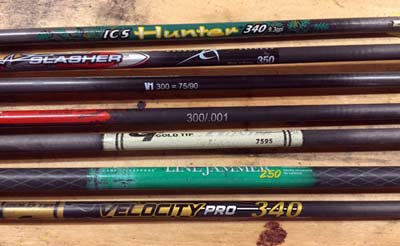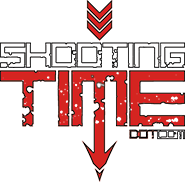Arrow spine is the term used to describe the stiffness of an arrow. An arrow with a weak spine will flex easier than an arrow with a stiff spine. Shooting an arrow with the correct arrow spine is very important for accuracy and consistency. Every bow transfers a different force to the arrow and the arrow has to have just the right amount of flex in order to correct itself in flight. If the the arrow’s spine is too weak or too stiff, the arrow will not correct itself as soon as it should while in flight.
Why is arrow spine important?
 It started back in the days when traditional bows were the only bows available. The older recurve and longbows did not feature a cutout riser that allowed the arrow to be seated in the centerline of the bow. Since the arrow was then off center while in the arrow rest or arrow shelf, during the shot it had to “bend” around the riser and correct itself or recover while in flight. Every bow demanded a specific arrow spine for accuracy and consistency.
It started back in the days when traditional bows were the only bows available. The older recurve and longbows did not feature a cutout riser that allowed the arrow to be seated in the centerline of the bow. Since the arrow was then off center while in the arrow rest or arrow shelf, during the shot it had to “bend” around the riser and correct itself or recover while in flight. Every bow demanded a specific arrow spine for accuracy and consistency.
With today’s modern compound bow, shooting an arrow with the correct spine is equally important. The arrows do not have to bend around the riser like back in the old days, but left to right string movement during a shot along with powerful cam systems still demand just the right amount of flex or spine in the arrow.
Static arrow spine and dynamic arrow spine
Static arrow spine
There are two types of arrow spines that we will talk about: static spine and dynamic spine. Static arrow spine is the spine of the arrow in the static, or stationary, state. When static spine is measured, arrow components such as field points, broadheads, fletchings, and nocks do not come into play. Static spine is solely measured on the arrow shaft.
How is static spine measured?
Static spine is measure by supporting an arrow on both ends, hanging a weight from the center, and measuring the deflection in thousandths of an inch. There are actually two standard methods use; one for wooden arrows and one for all other arrows.
Measuring static spine of aluminum and carbon arrows
To measure the spine of today’s modern compound bow arrows, you’ll need to set the arrow on two supports that are 28 inches apart and suspend a 1.94 lb weight from its center. The amount the arrow bends or deflects in thousandths of an inch is your spine measurement. If an arrow sags 1/4 of an inch, it’s spine will be 0.250″ or .250. If a weaker arrow deflects or sags 1/2 of an inch, it’s spine will be 0.500″ or .500.
Some manufacturers relay this spine measurement straight to the product. This is done by including the spine measurement right in the arrow name. For example, a Black Eagle Carnivore 300 has an arrow spine of….? Yeah, .300 spine. Some manufacturers make up their own numbering system. An archery arrow program will have the real spine value in it’s database so whether the manufacturer’s number on the shaft isn’t really too important.

Measuring the spine of wooden arrows
To measure the spine of a wooden arrow, set the arrow on two supports 26 inches apart and hand a 2 lb weight from its center. The amount the arrow bends or deflects in thousandths of an inch is your spine measurement of your wooden arrow.
Dynamic arrow spine
Dynamic arrow spine is the spine of the arrow during the shot. Many different factors affect the dynamic spine of the arrow. By adjusting the weight of arrow components or the length of an arrow, we can adjust the arrow’s dynamic spine. We can tweak these factors until the recovery rate of the arrow is optimal in flight.
How to adjust an arrow’s dynamic spine
Here is an example of some factors that affect dynamic spine:
- Tip weight – Increased tip weight will weaken an arrow’s dynamic spine. Decreased tip weight will stiffen dynamic arrow spine.To understand this, picture holding a car antenna and pushing two different objects. The first object you’re going to push is a bowling ball. Will the antenna flex? You bet it will. The heavy tip weight (bowling ball) made the spine or flexibility of the antenna very weak. Now picture pushing a ping pong ball with the antenna. Will the antenna flex? Not so much. The lighter tip weight (ping pong ball) allowed the antenna to maintain a stiff spine.
- Nock weight or rear weight – Adding weight to the rear of the arrow will increase or stiffen the arrow’s dynamic spine while removing weight from the rear of the arrow will decrease or weaken the arrow’s dynamic spine.
- Arrow length – Increasing an arrow’s length will weaken the arrow’s dynamic spine while shortening an arrow will stiffen the dynamic spine. Think of a pencil. How easily can you flex a brand new long pencil? Yeah, it’s pretty easy. Now try flexing a pencil that’s 3 inches long. Not so easy. With arrows, it’s the same. If you want to adjust your arrow’s spine, you can shorten your arrow. This decreases its ability to flex. You can do the opposite too; you can choose to shoot a longer arrow to get a weaker spine. The key is knowing what spine you need… and that is why archery software is a powerful tool.
- Increase or decrease your bow’s draw weight – Fast bows demand a stiffer arrow shaft. They impart more stress to the arrow during a shot cycle so the arrow has to be stiff enough resist too much paradoxing (flexing in flight).Slower bows require a weaker shaft. There is less energy transfer to the arrow so the arrow has to be weaker in spine so it does still flex some.
If in either setup, the spine is too weak, it will result in poor consistency and accuracy. The same can be said if the arrow’s spine is too strong. If the arrow isn’t allowed to flex or paradox just the right amount, it will be nearly impossible to achieve optimal accuracy and consistency.
The variables that affect an arrow’s dynamic spine and how we manage them are very important if we want to achieve ultimate accuracy in archery. There are quite a few archery programs that calculate dynamic spine based on your arrow shaft and bow selection. These archery programs eliminate guess work and arrow tuning/adjusting by trial and error. They calculate and deliver exactly what arrow shaft (spine specific), tip weight, arrow shaft length, and nock weight combination you need for the perfect spine. For Easton’s take on arrow spine, click here.
Properly spined arrows are more accurate and penetrate deeper
The bottom line is better performance. Having the right spine in an arrow will optimize accuracy and penetration. The accuracy is achieved because the arrow flexes the proper amount early in flight. This keeps fishtailing or wobbling to a minimum and allows the arrow to straighten out quickly. When an arrow is flying, well.. straight as an arrow, it can transfer maximum energy into its target. This is the equivalent to driving a 16 penny nail into a 4 x 4 with one swing of the hammer.
An arrow that doesn’t have the right spine and is still paradoxing at the point of impact will not penetrate like it should. This is due to the kinetic energy being “twanged” out of the arrow as it burrows in. If you have that one buddy that is always complaining about never getting a pass through shot on a deer or elk, this could be one of the reasons. Another example of how this works is by observing how far an arrow will penetrate into a target at different distances. You may be surprised that your arrow may penetrate more at 40 yards than it does at 20 yards. How can this be? Well, at 40 yards, that arrow has corrected its flight 100% and doesn’t lose any kinetic energy during penetration.
For a nice look at some arrow paradoxing in flight, check out this slow motion video of arrows in flight.
Once you have your acquired an arrow shaft of the perfect spine, it’s time to build your arrow. Click here to learn how to build the perfect arrow. (link coming soon)
